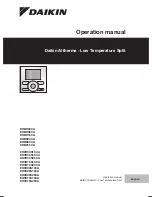
Safe Torque Off
vacon • 70
9
9.4
The principle of STO
The STO functionality, such as the technical principles and data (wiring examples and commission-
ing) will be described in this chapter.
In VACON
®
20 X, the STO function is realized by preventing the propagation of the control signals to
the inverter circuit.
The inverter power stage is disabled through redundant disabling paths which start from the two
separated and galvanically isolated STO inputs (S1-G1, S2-G2 in Figure 36). In addition, an isolated
output feedback is generated to improve the diagnostics of the STO function and to achieve a better
safety capability (F+, F- terminals). The values assumed by the STO output feedback are indicated
in the following table:
The diagram below is a conceptual schematic diagram and is presented to illustrate the safety
function with relevant safety components only shown.
Figure 36. STO function principle. (*) Only for MU3.
STO inputs
Operating conditions
STO feedback
output
Torque at the
motor shaft
Both inputs ener-
gized with 24V DC
Normal operation
The feedback must
be 0V
present (motor
on)
Power removed from
both inputs
STO demand
The feedback must
be 24V
disabled (motor
de-energized)
The STO inputs have
different values
Failure in demand or
due to internal fault
The feedback must
be 0V
disabled (motor
de-energized)(*)
Table 32. Values of the STO output feedback (and torque on the motor). (*) Only one channel
is preventing the drive from moving.
R
Reinforced
R
R
R
=
3
S1
G1
S2
G2
L1
L2
L3
F+
F-
U
V
W
DC+/R+
R-
POWER UNIT
DC-*
Phone: 800.894.0412 - Fax: 888.723.4773 - Web: www.clrwtr.com - Email: [email protected]











































